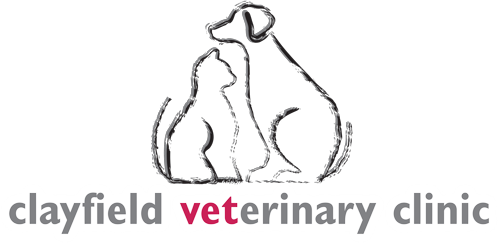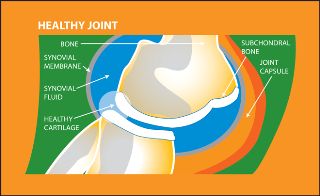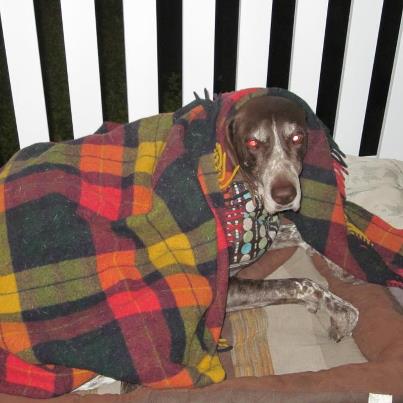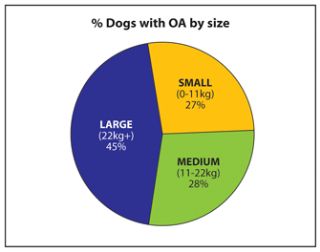
Joint Health
What is arthritis?
As your dog walks, runs and plays, opposing forces are created when their body weight pushes down against the ground. These forces are concentrated at the point where the two moving bones meet, the joint. Joints must effectively disperse these forces in order to protect the moving bones from damage, while at the same time allowing them the freedom of movement. Cartilage and synovial fluid are the two elements of a joint that allow this to happen.
Cartilage
Cartilage acts as a cushion between the joints, preventing the bones from rubbing together and acting as a shock absorber. It compresses and flattens to disperse the load evenly.
Synovial Fluid
The joint capsule contains synovial fluid which flows over the compressed cartilage allowing the two moving bones to glide over one another in a near frictionless movement. It lubricates the joint in a similar fashion to the way engine oil in a car lubricates the pistons as they move.


The disease develops over a long period of time and only when the disease is well progressed do any symptoms begin to show. In the latter stages, osteoarthritis becomes a debilitating and painful disease that can greatly affect the quality of life of your dog. Unfortunately, it is one of the leading reasons that owners get their dogs euthanised, but there is plenty that owners can do to prevent the painful and debilitating effects of osteoarthritis.
A Joint Health Protection Program is recommended for dogs that have high risk of developing osteoarthritis. This will maintain healthy joints and help slow the progression of the disease for those dogs that may be in the early stages of osteoarthritis. A Joint Health Treatment Program is recommended for those dogs that are already exhibiting symptoms.
What are the signs of Osteoarthritis?
Osteoarthritis is difficult to identify in its early stages. In the latter stages symptoms may include:
- Limping or stiffness
- Difficulty in getting up after resting
- Difficulty in taking stairs or jumping in or out of a car or chair
- Changes in character which may include aggression
- Less energetic than normal
- Loss of appetite
- Painful, swollen or warm joints
- Persistent licking of joints

Our gorgeous Ella (pictured above all rugged up on cold winter morning) had just turned 6 when we started her on a joint protection program.
Many dogs will suffer from the painful symptoms of osteoarthritis as they get older. When most people think of osteoarthritis, they only think of older pets. While aging is commonly associated with osteoarthritis, there are other risk factors which contribute, making some dogs at a higher risk. Dogs that fall into the high risk categories below may develop osteoarthritis earlier in life and may develop painful symptoms at a very young age. If your dog falls into any of these risk categories, it is strongly recommended that you contact us to find out how to protect them today.
Is my dog at risk?
1. Breed / Genetic Predisposition
Some breeds are genetically pre-disposed to developing joint abnormalities, such as joint dysplasia which often leads to Osteoarthritis.
2. Size
Large breeds are much more susceptible to the development of Osteoarthritis. This could be because their high body weight causes trauma and disruption to the joint which triggers Osteoarthritis. As the graph indicates; 45% of dogs with Osteoarthritis are large breeds, 28% are medium breeds and 27% are small breeds. This demonstrates that Osteoarthritis is still common in medium and small breeds.

3. Excess weight
Diet and weight play a key role in the development of Osteoarthritis in dogs. Overfeeding dogs causes an increase in body weight which can overload the skeleton and contribute to the development of joint damage and Osteoarthritis.
4. Joint Trauma / Injury
Joint trauma or joint surgery is a major predisposing risk factor in the later development of Osteoarthritis.
5. Age
It is expected that the chances of developing Osteoarthritis will increase with age. However, it is important to note that Osteoarthritis is not exclusively a disease that affects older dogs. You should consider protecting your dog from Osteoarthritis from the age 3-5 years.
What is a Joint Health Program?
A Joint Health Program is individually tailored by us to maintain joint health in your dog. It is a holistic approach that takes into account lifestyle changes, nutrition, exercise and different management therapies to ensure your dog lives a happy and healthy life well into their old age, without the painful and debilitating effects of osteoarthritis.
Joint Health Protection Program
A proactive Joint Health Protection Program is recommended for dogs that have a high risk if developing osteoarthritis but aren’t showing any symptoms. This will maintain healthy joints and help slow the progression of the disease for those dogs that may be in the early stages of osteoarthritis where there are no visible symptoms. It’s important to take a proactive approach to joint health as by the time symptoms begin to show, the disease is well progressed.
Joint Health Treatment Program
A Joint Health Treatment Program is recommended for those dogs that are already exhibiting symptoms. By this stage the disease is quite advanced, but there are still things that can be done to maintain quality of life.
We can help you to
- Learn how to recognise early warning signs
- Discover how to make simple lifestyle changes (including diet and nutrition, bedding and exercise programs) to enhance your dog’s quality of life and reduce arthritic symptoms
- Gain valuable information about how to protect your dog from osteoarthritis
- Find out the latest information regarding treatments and protection programs available
- Determine if your dog is at risk and tailor an individual program for your pet to minimise that risk
Did you know that the early stages of osteoarthritis have no obvious symptoms and can easily go undetected? If your dog is comfortable at the moment, now is the perfect time to equip yourself with the information on how to maintain this quality of life as they get older. Even if your dog has symptoms of osteoarthritis, it isn’t too late to do something. There are plenty of things you can do to help. Call us on 3262 1988 to find out how you can make a difference.
3. Excess weight
Diet and weight play a key role in the development of Osteoarthritis in dogs. Overfeeding dogs causes an increase in body weight which can overload the skeleton and contribute to the development of joint damage and Osteoarthritis.
4. Joint Trauma / Injury
Joint trauma or joint surgery is a major predisposing risk factor in the later development of Osteoarthritis.
5. Age
It is expected that the chances of developing Osteoarthritis will increase with age. However, it is important to note that Osteoarthritis is not exclusively a disease that affects older dogs. You should consider protecting your dog from Osteoarthritis from the age 3-5 years.
What is a Joint Health Program?
A Joint Health Program is individually tailored by us to maintain joint health in your dog. It is a holistic approach that takes into account lifestyle changes, nutrition, exercise and different management therapies to ensure your dog lives a happy and healthy life well into their old age, without the painful and debilitating effects of osteoarthritis.
Joint Health Protection Program
A proactive Joint Health Protection Program is recommended for dogs that have a high risk if developing osteoarthritis but aren’t showing any symptoms. This will maintain healthy joints and help slow the progression of the disease for those dogs that may be in the early stages of osteoarthritis where there are no visible symptoms. It’s important to take a proactive approach to joint health as by the time symptoms begin to show, the disease is well progressed.
Joint Health Treatment Program
A Joint Health Treatment Program is recommended for those dogs that are already exhibiting symptoms. By this stage the disease is quite advanced, but there are still things that can be done to maintain quality of life.
We can help you to
- Learn how to recognise early warning signs
- Discover how to make simple lifestyle changes (including diet and nutrition, bedding and exercise programs) to enhance your dog’s quality of life and reduce arthritic symptoms
- Gain valuable information about how to protect your dog from osteoarthritis
- Find out the latest information regarding treatments and protection programs available
- Determine if your dog is at risk and tailor an individual program for your pet to minimise that risk
Did you know that the early stages of osteoarthritis have no obvious symptoms and can easily go undetected? If your dog is comfortable at the moment, now is the perfect time to equip yourself with the information on how to maintain this quality of life as they get older. Even if your dog has symptoms of osteoarthritis, it isn’t too late to do something. There are plenty of things you can do to help. Call us on 3262 1988 to find out how you can make a difference.
Did you know that 90% of cats over the age of 12 suffer from Osteoarthritis?
A new product has very recently become available for the management of painful arthritic change in cats. Find out more about how we can assist your cat by reading our article: Creaky Cats
